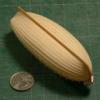-
Posts
13,276 -
Joined
-
Last visited
Content Type
Profiles
Forums
Gallery
Events
Everything posted by druxey
-
I had no idea that Seccotine was still available. I remember it (and its distinctive odour!) from my childhood modelling days. Ratlines are usually tied using clove hitches, but at such a small scale your suggestion will look much neater and be a bit quicker! Those shortbread cookies will give you the energy for the job.
- 10 replies
-
- restoration
- finished
-
(and 1 more)
Tagged with:
-

Tabled Clamps
druxey replied to allanyed's topic in Building, Framing, Planking and plating a ships hull and deck
'Tabled in the meeting edges' clinches the newest illustration as correct for me, Allan. -
And they are actually miniature Swiss files (about 4 ½" long instead of 6").
-
It appears to be a 'decorative' model loosely based on what was believed to look like the Henry Grace a Dieu. (No-one knows what she actually looked like!) Gunports would never have been placed one immediately under another. It's an interesting memento of your grandfather.
-
Can you make the gratings first, then add the rail and finally slide the gratings into place under the rail?
-
May I add my condolences. Gerald was a master craftsman and shared his knowledge freely. As it was said of Christopher Wren, si monumentam requirat, circumspice; If you need a memorial, look around. His work will endure.
- 281 replies
-
- falls of clyde
- tanker
-
(and 2 more)
Tagged with:
-
Yup, Justin, if you are a conservator you know that only too well!
-
Good morning indeed! Superb work as usual.
-
Doomed to make models!
- 221 replies
-
- queen anne barge
- Syren Ship Model Company
-
(and 1 more)
Tagged with:
-
If the ink is water-soluble (and most printer ink is!), the water content in acrylics will make things run. Not good.
- 1,784 replies
-
- winchelsea
- Syren Ship Model Company
-
(and 1 more)
Tagged with:
-
In the 18th century there were two types of ballast. The permanent ballast was usually pig iron bars in various sizes. Occasionally old cannon were also used. The ballast was stowed on either side of the limbers (drainage channels) each side of the keelson. Above this was shingle ballast. As you describe, these were smooth, rounded stones - usually from a sea beach, not a river. This was moveable and the lowest tier of stowage (usually barrels) were bedded on the shingle.
-

Cutty Sark lift interfering with topmast shrouds?
druxey replied to Bruma's topic in Masting, rigging and sails
A fixed yard is another story! -

Cutty Sark lift interfering with topmast shrouds?
druxey replied to Bruma's topic in Masting, rigging and sails
The yards in the photo are without sails in a lowered position, I think. When raised and sails bent there is more clearance with the shrouds. -
You might consider washes of acrylic paint. As far as I know, this is non-acidic in nature. Can anyone confirm this?
-

Converting a Backyard Shed into a Model Workshop
druxey replied to Hank's topic in Modeling tools and Workshop Equipment
You expected regular stud spacing and everything to be truly square? Oh, the naiviety! -

Ship lettering
druxey replied to rlundy90's topic in Painting, finishing and weathering products and techniques
I'm amazed that this stuff is still around. I heaved the remains of my then ageing and crazed Letraset (I was in graphic design back then) about 25 years ago!
About us
Modelshipworld - Advancing Ship Modeling through Research
SSL Secured
Your security is important for us so this Website is SSL-Secured
NRG Mailing Address
Nautical Research Guild
237 South Lincoln Street
Westmont IL, 60559-1917
Model Ship World ® and the MSW logo are Registered Trademarks, and belong to the Nautical Research Guild (United States Patent and Trademark Office: No. 6,929,264 & No. 6,929,274, registered Dec. 20, 2022)
Helpful Links
About the NRG
If you enjoy building ship models that are historically accurate as well as beautiful, then The Nautical Research Guild (NRG) is just right for you.
The Guild is a non-profit educational organization whose mission is to “Advance Ship Modeling Through Research”. We provide support to our members in their efforts to raise the quality of their model ships.
The Nautical Research Guild has published our world-renowned quarterly magazine, The Nautical Research Journal, since 1955. The pages of the Journal are full of articles by accomplished ship modelers who show you how they create those exquisite details on their models, and by maritime historians who show you the correct details to build. The Journal is available in both print and digital editions. Go to the NRG web site (www.thenrg.org) to download a complimentary digital copy of the Journal. The NRG also publishes plan sets, books and compilations of back issues of the Journal and the former Ships in Scale and Model Ship Builder magazines.


